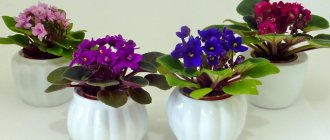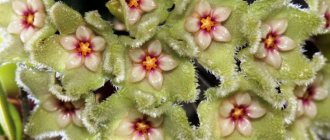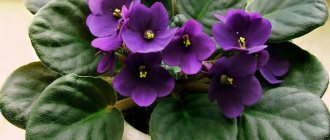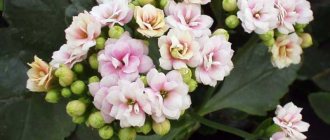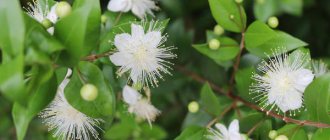How to properly grow indoor violets at home?
The violet is a houseplant that is a rosette of rounded leaves that is attached directly to the root system. The complete absence of a stem makes it unlike all other decorative flowers. Avid flower growers love violets for their bright and memorable appearance. Unlike many other indoor plants, it has a variety of colors, which allows you to use it to create floral compositions that become the highlight of your living space.
But violets also have a small drawback. She loves to be carefully looked after. If you do it incorrectly, it is unlikely to delight you with its bright blooms. If you want to learn how to properly water, feed and replant violets, then read our article.
History of origin
The wild plant was first discovered in East Africa. The governor of the Uzumbara district, Saint-Paul, noticed the flower during his forays and sent the seeds to Germany to the then famous botanist Hermann Wenland. Having sprouted the seeds into an adult flowering plant, the scientist described the flower and came to the conclusion that he had discovered a new genus belonging to the Gesneriaceae family.
Soon, Wenland presented a new species at the World Flower Exhibition and attracted great attention from breeders and flower growers to the plant. Thanks to the long flowering period, a huge number of varieties of Uzambara violet have been developed.
The selection process continues to this day, allowing connoisseurs of this beautiful flower to receive interesting new products.
Origin and description of Saintpaulia
It was discovered at the end of the 19th century by Baron Walter von Saint-Paul, admiring the Uzambara mountains, in whose honor it received its name.
A year after its discovery, violet (Saintpaulia) became a participant in the World Flower Exhibition, and flower growers noticed it there. In the first third of the 20th century, these flowers ended up in the USA, where they became popular as indoor Saintpaulias.
Varieties of Saintpaulia
Today, Saintpaulia, whose varieties number several thousand, thanks to breeding work, amazes with its variety of shades. Let's look at what kind of Saintpaulia there is: photos, names, descriptions of some species.
- Saintpaulia dark - has a straight stem 10 cm high. The color of the flowers, collected in fours together, is violet-blue, the anthers are yellow.
- Saintpaulia violetflower (violet flower). Under natural conditions, flowers have a blue-violet hue. Cultivated specimens have a wide range of colors: white, blue, pink, purple, red. The leaf blade has a green top and a green-red bottom.
- Saintpaulia magungen. Branched stems can be up to 15 cm tall, the diameter of the leaf with a wavy edge is approximately 6 cm. The flowers are purple in color, collected in 2-4 groups.
- Saintpaulia Teitean. It is a protected species native to the southeastern mountains of Kenya. Difficult to grow indoors. It is spectacular. It has blue-violet flowers with a dark center.
Soil for Saintpaulia
One of the main requirements for soil is its looseness. Loose soil retains moisture well and provides oxygen access to the roots of the plant.
When purchasing soil for Uzumbara violet, remember that universal soil is not suitable. Look in stores for specialized substrate for violets.
If you prefer to prepare the soil yourself, the following proportion is recommended: 1 portion of coarse sand, 3 portions of peat and 5 portions of leaf humus. Mix all this, sprinkle it with phytosporin for prevention and leave it in a planting pot, covered with polyethylene, for a couple of days.
Temperature
Uzumbara violet feels comfortable in the temperature range of +20°С…+25°С. The main condition for the normal development of a plant is the absence of sudden temperature changes. Care in room conditions can adequately ensure the absence of temperature changes.
Spraying
Indoor Saintpaulia flowers are strictly not allowed to be sprayed. Water particles collect in large drops on velvet leaves and lead to the appearance of unsightly spots and streaks. Another danger from spraying is that water from the leaves will flow into the rosette and cause the plant to rot.
If the air in the room is dry, choose any methods of humidification other than spraying.
Watering
Watering violets is carried out with settled water at room temperature. You can also use melt and rain water for irrigation.
In their practice, flower growers use 3 watering methods when caring for violets. Each of these methods has its own advantages and disadvantages. Let's figure out how to water a flower using these methods.
Types of violets
The most popular among flower growers is dark violet . The reason is the purple-black color. It is strengthened by the fact that the buds are collected in inflorescences of 4 pieces. The yellow anthers of the stamens look impressive against a dark background. There are 5 of them in each bud.
Indoor violets in dark shades are very popular among gardeners
Those who once fell in love with the violet plant, as a rule, no longer change their passion. Some choose wild species, others choose selective ones. Dark varieties belong to the latter, like violet le . This name hides the abbreviation of the name Elena Lebetskaya. She has been developing new varieties for 15 years.
The woman created more than 250 previously unseen varieties. All of them are intended for indoor floriculture. A special feature of Elena’s varieties are the buds of the terry type, with fringe or fancy coloring.
Fans of wild species usually choose Altai species. The homeland of these violets is Russia. Although, most of the flowers in the family are African. Altai shoots are distinguished by triangular stems and single planted buds. They are blue-violet, based on long petioles. The diameter of the flowers is about 3 centimeters.
Altai violet reaches 20 centimeters. Those who want to have an even smaller plant, but untouched by selection, pay attention to the mountain species. This violet requires careful care at home .
In particular, shoots need coolness, just like in the mountains. Flower growers try to satisfy requests, because the effort is worth it. A “carpet” of shoots only 5 centimeters high blooms in pots. The buds on them bloom large, blue or purple.
Altai violet is a miniature plant growing in the mountains
The buds of the graceful violet are yellow . Copies of it are rarely made from beads The species is known only to botanists and avid gardeners. The height of the shoots is from 10 to 20 centimeters. The diameter of the buds is approximately 4 centimeters. The graceful violet blooms from spring to autumn, which is unusual for representatives of the genus.
In general, about one and a half thousand varieties are grown at home. These are the same 30 species. Only the most popular ones are listed. By the way, hybrids and selection samples are usually called Saintpaulias. The wild variants of the plant are called violets. But the rules for caring for both are the same. Let's find out how to care for the selected flowers.
Top watering
Pour water from above under the root of the plant, avoiding getting between the stems. After the water has soaked the entire pot and flows into the pan, drain it.
The disadvantage of this method of watering is that water will accidentally get into the outlet and lead to plant disease.
Bottom watering
With this method, water is poured into a tray and left for an hour and a half. After this time, the remaining water in the pan must be poured out, and after another half hour, a control inspection must be performed again.
This method is definitely not suitable for forgetful people. If the violet sits too long in water, its roots will begin to rot and die.
Wick watering
They are used by professional flower growers who have a large number of Saintpaulias. The fabric filter is twisted into a tube and one end is placed in a container with water, and the other is placed in a spiral on the bottom of the pot before replanting the plant.
Thus, the violet takes from the filter exactly as much moisture as it needs. Your task is to ensure that there is always water in the container.
Features of violet
Violet is a plant of the Violet family. All types of flower are perennial herbs growing from 15 to 40 centimeters. Varieties of violets are also united by the structure of the rhizome. It is thick and woody. Plant stems are shortened. Their growth is so slow that the emerging leaves are located close to each other, folding into rosettes.
The root is not only greenery, but also flower stalks of violets . Photos of plants begin to be taken in the spring. At this time, the first buds open. They are solitary, consisting of 5 lanceolate or ovoid petals. The violet leaves are also rounded . They are solid, with oval or heart-shaped contours. There are small notches along the edge.
Hybrids of indoor violets are called Saintpaulias.
Violet greens can be smooth or velvety. Short hairs cover the foliage of about half the plant species. There are varieties in which the petals of the buds are also pubescent.
By autumn, violet flowers turn into boxes with seeds. They are oblong, ovoid, smooth. In order for the seeds to spill out onto the ground, 3 doors must open. Domestic violet seeds are used only for propagation of the crop.
The stems, leaves and flowers are also suitable for medicine. They are good against inflammation and as antiseptics, helping with colds, kidney ailments, and gastrointestinal tract.
The medicinal properties of the flower are due to the substances it accumulates. Indoor violet contains carotene, rutin, salicylic acid and vitamin C. The tissue composition also contains glycosides. All these elements are necessary for the health of the body.
True, violets also have contraindications: hepatitis and glomerulonephritis. It wouldn’t hurt to consult a doctor even if there are no prohibitions. Exceeding the dosage, or using decoctions for too long, leads to nausea, vomiting, and loose stools.
In addition to biological, nutritional, medicinal, violet also has a symbolic description. So, in France, a flower is a sign of constancy, eternal love. The peoples of Scandinavia revere the violet as a symbol of innocence and modesty. In Ancient Rome, the plant was associated with Jupiter - the God of Gods. So, from the Romans' point of view, the queen of flowers is not the rose, but the violet.
About 30 of the 600 plant species are grown at home Botanists divide them into 16 genera. According to their purpose, they are divided into wild or forest, garden and indoor. Let's consider options suitable for cultivation at home.
Top dressing
In its historical homeland, our houseplant lives on soil that contains few nutrients. An excess of fertilizing can have a detrimental effect on the plant.
Particular care should be taken when using fertilizers with a high nitrogen content, which are used for decorative deciduous plants. From such food the violet will stop flowering and begin to grow rapidly.
It is recommended to feed Saintpaulia from April to November, finally suspending the procedure in winter. As a top dressing, purchase complex fertilizer for flowering plants in stores.
It is forbidden to fertilize the plant within a month after transplantation; during extreme temperature changes; in case of plant disease.
A little history
The year was 1892, and the powerful Baron Albert Walter Radcliffe de Tan von Saint-Paul was lucky enough to become commandant of the Uzumbara district. It was the military man who managed to discover such a unique plant as violet.
Today, Tanzania, Burundi and Rwanda stand on that historical territory. The commandant hastened to send the seeds to his own father, who headed the German dendrological community. Father, having received an amazing parcel, contacted the botanist Wendland.
He grew an adult specimen of a houseplant, which dates back to 1893. The scientist named the resulting botanical masterpiece Saintpaulia violetflower, separating it into a personal genus.
The exhibition, held in Ghent, presented to the general public a huge number of different flowers, among which the violet stood out brightly. As a result of the exhibition event, industrial cultivation of the new plant was launched.
In 1927, this beautiful miracle of nature came to North America, and quickly earned the love of flower growers. By 1949, the varietal diversity of violets exceeded one hundred species.
Transfer
When choosing a container for a violet, remember that the diameter of the pot should be 3 times smaller than the diameter of the rosette. The capacity of an adult plant is usually 13 cm in diameter and 10 cm in height.
If you transplant the plant into a larger pot, you risk never enjoying the flowering of Saintpaulia.
The plant itself is difficult to tolerate the process of transplantation. Delicate thin roots are highly susceptible to mechanical damage. Therefore, it is recommended to transfer the plant with a lump of earth into a larger pot.
If you find the presence of rotting on the roots, remove it and, for prevention, place the treated roots in a solution of potassium permanganate.
How to care for Saintpaulia at home
Let's consider caring for Saintpaulia at home.
The success of the Uzambara violet is due to the variety of varieties and long flowering. In addition, it does not require extra space, so different species can stand side by side on the windowsill, each with its own shade of flowers.
Saintpaulia at home loves lighting without direct sunlight. A window in the west and east will suit it, and in winter it should be moved to the south (you can also cover the windows with fabric or place the perennial on the bedside table nearby).
A young violet is comfortable at a temperature of 23-25°, an adult – 20-24° is enough. The degrees day and night should not differ much - this harms the plant, as do drafts.
Saintpaulia appreciates moisture, but spraying should not be used on it; it is better to moisten it differently.
Watering
Watering Saintpaulia is carried out with tap water, but you can use rain or melt water - the main thing is that the liquid is clean and well settled. It is necessary to water at the root, avoiding water getting into the rosette of the flower and onto the foliage.
- The intensity of watering depends on the weather: in cold weather we moisten the soil less, in warm weather - more.
- You can look at a Saintpaulia leaf: elastic and fleshy indicates sufficient watering, while limp and drooping indicates a lack of moisture.
- In dry soil, thin roots that usually absorb moisture die.
- Too wet soil will lead to rotting of all the roots (this happens when the pot is too large for the plant), so the violet should be watered monthly with a light solution of manganese, protecting it from fungus.
Loosening Saintpaulia
Roots need free access to oxygen. This means that loose soil that simultaneously retains moisture (turf soil, leaf humus, sand, sphagnum moss) would be appropriate.
All gardeners prepare planting soil according to their own recipes, but it is also available for sale. Add a little perlite, peat moss or coconut substrate to the finished earthen mixture. Coniferous soil (with the addition of leafy soil) is also suitable.
Transplanting Saintpaulia
Saintpaulia is a compact flower; at first it only needs a small pot. However, as it grows, it requires transplanting into a larger container.
The pot is also changed if the development of the perennial slows down.
It is urgently replanted when the root system rots or there is an overdose of fertilizers.
Moreover, it is better to use the transshipment method, because the plant has delicate roots. Having transferred the flower with a lump of earth into another container, you need to add the missing soil.
According to botanists, the bright beauty grows better in a container whose diameter is 3 times smaller than its rosette.
Typically, pots with a diameter of 10-13 cm and 10 cm in height are considered optimal for violets - then there will be large foliage and flowers. If the container is too large, the plant will not reach the flowering stage.
Feeding Saintpaulia
After one and a half months, you can feed the transplanted adult perennial with fertilizers for flowering plants, doing this regularly. Some gardeners eliminate fertilizing, changing the pot once every 6 months to a slightly larger one than it was before.
Pruning Saintpaulia
After a certain period, the lower leaves of the plant die off, leading to loss of decorativeness and poor flowering.
Violet rejuvenation will be required. To do this, cut off the top, treat the cut with a composition that stimulates root growth, and plant it in freshly prepared soil.
From the part left in the pot, stepsons will soon grow that can be rooted.
Saintpaulia loves careful and careful care, which is the key to her health and beauty.
Rest period
Saintpaulia, fortunately for many gardeners, is an evergreen plant in which, unlike gloxinia, the above-ground part does not die off in winter.
The dormant period is considered to be the time when the violet rests from continuous flowering. Try to provide the violet with a more shaded place with moderate watering. This will allow you to form even more beautiful buds for the new active period.
Caring for Saintpaulia at home. Briefly
The culture has proven itself to be unpretentious. If you have basic skills, even a novice gardener can grow it. In order for Saintpaulia to feel comfortable at home, a number of parameters must be observed.
Basic requirements (memo):
| Temperature | In winter it should be at least 19˚C, in summer – about 22-25˚C. |
| Air humidity | 55-65%, however, you cannot irrigate the leaves with a spray bottle (to increase the indicator, the pots are placed on expanded clay, which is then sprayed with water). |
| Lighting | Moderate, placement on northern windows is acceptable. |
| Watering Saintpaulia | Depending on the season of the year (in summer, moisten the soil daily, in winter - once every 4 days). |
| Priming | Well-draining, specially designed for violets. |
| Feeding and fertilizer | Only in the warm season (once every 2 weeks). |
| Transfer | Annual (spring) with complete soil replacement. |
| Propagation of Saintpaulia | It is carried out by apical cuttings, air layering and parts of the stem so that several buds are present on it. |
| Peculiarities | Ease of propagation (by cuttings, “babies”, seeds), the possibility of obtaining new varieties with unusual petal colors through artificial pollination. |
The advantage of the Uzambara violet is that there is no need for pruning. The procedure is resorted to if weak leaf plates appear on the Saintpaulia, in case of mechanical damage, and also in order to obtain new plants.
Rejuvenation
The Saintpaulia plant grows quickly and does not lose its attractiveness for more than 4 years. However, over time, the lower leaves die off, the rosette becomes less lush, and flowering is not so abundant.
The most effective way of rejuvenation is cutting off the top. The cut site should be treated with root (root growth stimulator) and planted in the prepared substrate. For better survival and adaptation, the plant should be shaded and covered with a transparent cap.
Stepsoning
Do not throw away the remaining part of the old violet that you rejuvenated. After a certain time, the plant will release daughter shoots (stepchildren). When the stepsons reach 5 cm in diameter, it is recommended to separate them from the mother plant and transplant them into a separate pot.
Leaf cuttings
The most popular method of propagating violets is using leaf cuttings. From an adult healthy plant, it is necessary to cut off the plate from the bottom row of the rosette with a sterile instrument. The Saintpaulia wound must be treated with activated carbon dust.
Add 1 tablet of activated carbon powder to a glass of settled water and place the prepared cuttings in it. Make sure that the leaf part of the cutting is not in the water; only the stem should be there.
After 3 weeks, the first roots can be seen on the leaf. As soon as this happens, you should plant the leaves in containers, without deepening them into the ground, and cover them with film for a couple of weeks for rooting.
Transplantation and propagation of indoor violets
A complete replacement of the substrate, as part of caring for indoor violets, is necessary once every 3 years. Young specimens can be transplanted into larger containers every spring, but use the transshipment method. It will be enough to replace the drainage and depleted topsoil.
Indoor violets propagate very simply using leaves. To do this, take a mature and healthy leaf, cutting it as close to the ground as possible. Too large a “stump” can rot and destroy an adult plant. It is better to cut the cutting at an angle of 45°, and root the leaf in the ground at the same angle. You can use the same Saintpaulia mixture as a substrate, but dilute it halfway with calcined river sand. For planting, it is better to choose plastic cups, but poke several drainage holes in them with an awl or scissors. After planting the cutting, the cup can be covered with a plastic bag; in such a “greenhouse” the plant will take root better. Some people prefer to first get the roots of the cutting in a jar of water, however, when planting such a leaf in the ground, care should be taken, because young roots are very fragile.
Important! In a pot that is too spacious, the violet will not bloom until it has completely encircled the earthen ball with its roots.
Seeds
The most difficult method of propagating violets, requiring practical skills and experience from the grower.
Initially, you should choose two of your favorites for cross-pollination. Using a soft brush, transfer pollen from one violet flower to another. If you did everything correctly, then after 4 months the seeds will ripen on the fertilized specimen.
Place the seeds in a prepared container with loose, moistened soil and cover with polyethylene or glass. As the plants grow and develop, plant them in separate containers.
Features of the plant and interesting facts about violet
Violets are very delicate, fragile and at the same time they are resistant to various irritants and changes in conditions. Saintpaulias tolerate shortcomings of care well if they are not neglected critically.
Interestingly, there are two legends about the appearance of violets on the slopes of the African mountains:
- the first legend talks about Adam's tears, which turned into Saintpaulia flowers;
- the second version is Greek - Zeus, the supreme god of Olympus, turned a nymph running away from Apollo and asking for protection into this flower.
They also believe that violets should not be placed in the house of unmarried women , because they drive men away from the house. But this sign accompanies many colors, most often without reason.
Insect pests
Most often the plant is attacked by the following parasites:
- Mealybugs. A white cotton-like coating forms on the cuttings of the plant.
- Thrips. The flowers dry quickly and yellow dust forms on the leaves.
- Cyclamen mites. The young leaves curl up, and the adults have longer hairs.
- Nematodes. The roots of the plant are affected. The most dangerous type of pests, since their influence is not immediately noticeable, but only during transplantation. A plant infected with nematodes lags behind in development, blooms poorly, and young leaves grow ugly and curled.
If you find pests on your violets, take action immediately. Protect the sick plant from healthy ones and treat it with special preparations. After processing, it is recommended to wrap the violet in plastic for a couple of days.
Diseases and pests
Saintpaulias are not highly resistant to disease. However, with proper prevention, they can be protected from harm.
Insects and arachnids
The type of pest is determined by its characteristic symptoms (signs).
The most common:
- a white cotton-like coating on Saintpaulia cuttings appears when affected by mealybugs;
- quickly drying flowers and yellow pollen on the leaves are observed when attacked by Californian thrips;
- The upper leaves of Saintpaulia curl up, and the villi on the plates lengthen if cyclamen mites have settled on the plant.
Insecticides are used to eliminate parasites. In the latter case, biological or chemical acaricidal drugs can help.
Diseases
The cause of such conditions often lies in improper care. Most often, flower growers observe on violets:
- Saintpaulia does not bloom - due to excess nitrogen in the soil or lack of lighting;
- spots on the leaves of Saintpaulia - as a result of watering with cold water, exposure to drafts, direct sunlight;
- decrease in leaf turgor - when the substrate becomes waterlogged or dry;
- withering of unopened buds - due to decreased air humidity;
- grinding the central leaves of the rosette - in dry air or excess lighting;
- the edges of Saintpaulia leaves dry out - as a result of rare fertilizing;
- white coating on the above-ground parts of Saintpaulia - when affected by a fungus (“powdery mildew”);
- yellowing or redness of leaves - as a result of lack of nutrients;
- leaf rotting - due to the proliferation of late blight or gray rot pathogens.
Specimens must be inspected daily for signs of illness. If any are detected, treatment is started immediately to avoid the death of the plant.
If you need to go on vacation
It is not recommended to leave Saintpaulias for more than two days. If you expect a long absence, you need to ask someone to periodically water the substrate and monitor the humidity level in the room. Care should also include timely application of fertilizers.
If there is no assistant, and departure is inevitable, you can equip the pots with a wick watering system.
Diseases
Violets are susceptible to the following diseases:
- Powdery mildew is a fungal disease that is transmitted through fungal spores. It is expressed in a white coating on the leaves. Over time, the leaves on violets become deformed and die.
- Fusarium is a fungal disease that affects the root system of violets. The fungus rises through the vessels into the leaves of the plant. During the active phase of development, moist light brown spots appear on the leaves. The leaf cuttings begin to rot. Unfortunately, the plant cannot be saved. You should get rid of it as soon as possible.
- Gray rot is a disease that occurs when violets are grown at low temperatures. Appears in the form of brown spots with mold. The disease weakens the plant's rosette, liquefies the roots and cuttings. To save the plant, it is necessary to remove all leaves with signs of infection, preventing the infection from entering the soil.
Keep an eye on your plants, inspect them carefully once a week and respond immediately to any changes.
A healthy plant can resist diseases and will delight you with long and abundant flowering. Take a photo of Saintpaulia, share it with your friends, exchange leaves and expand your collection.
Short description
Growing violets at home will not be difficult if you familiarize yourself with the characteristics of the plant in advance. So, it is important to know the following:
- Flowering occurs almost all year round;
- Lighting for normal flower growth should be bright, mostly diffused. If you need to choose a window to place flower pots, it is better to look in the northwest, northeast or north;
- Temperature also affects flowers, since the intensive growth phase requires heating from 18 degrees to 24, and in winter the room should not be colder than 15 degrees;
- Watering is done systematically, no more than twice a week. Once every week and a half, it is best to use the bottom watering method;
- The appropriate air humidity is that which is typical for residential premises;
- Fertilizers are required in small quantities only during the active growth phase. Complex mineral fertilizer for flowering indoor plants is applied to the soil three times a month.
- The dormant period is not clearly visible, although in the winter months it is better to allow the bushes to rest;
- Replanting is permissible once a year, but there is no need to increase the capacity of the pot; it is enough to simply replace the soil mixture;
- Reproduction occurs using the seed method, children and leaf cuttings;
- Pests can cause serious damage to the plant. The list of enemies of violets includes aphids, nematodes, spider mites, whiteflies and others;
- Diseases include rust, late blight, powdery mildew, gray mold and fusarios.


